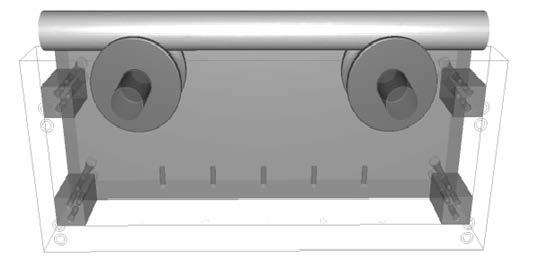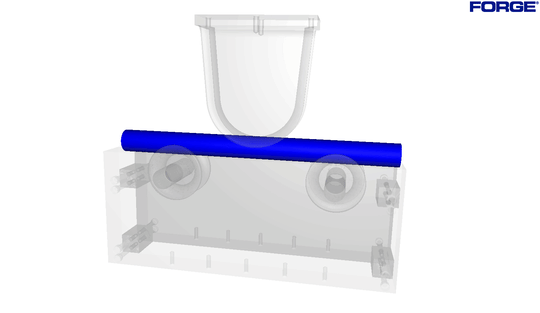Anchor harvey
 Anchor Harvey is a US-based aluminum forging company that relies on data-driven practices, boasting a rich history spanning a century in precision manufacturing, engineering, and supply chain management. By implementing advanced technology, we have revolutionized the traditional aluminum forging process, enabling meticulous monitoring and control at every stage. This ensures consistent part quality whether we produce 1 or +1,000,000 pieces.
Anchor Harvey is a US-based aluminum forging company that relies on data-driven practices, boasting a rich history spanning a century in precision manufacturing, engineering, and supply chain management. By implementing advanced technology, we have revolutionized the traditional aluminum forging process, enabling meticulous monitoring and control at every stage. This ensures consistent part quality whether we produce 1 or +1,000,000 pieces.
Challenge: Design bend tooling into a "U" shape that aligns with the desired specifications
Hot bending a 2.375 diameter 6061 aluminum billet into a "U" shape presents numerous challenges. The process involves critical factors such as temperature control, bending method, bending equipment, bend radius and angle, heat distribution, post-bending treatment, and quality control. Attaining the desired shape necessitates careful consideration of these factors.
However, this type of bender can cause galling on the outer surface of the aluminum billet, leading to flaws on the parts. Various coatings have been attempted on the original bender to reduce friction, but they have had limited effect on the billet's surface. Lubricating the roller bender before each hit is done to help prevent galling. Furthermore, the design of the bend tooling poses a specific challenge. Current design generates misalignment and repeatability issues. The bend tooling must be meticulously engineered to ensure that the
resulting bent shape aligns with the requirements of the intended part.

Initial design of the bottom bender for producing the U-shaped billet.
Solution: Export an STL file to overlay the "U" shape onto our forge dies in CAD, ensuring that the bent shape would be compatible with the desired specifications for this particular part
Thanks to the bending simulation, we were able to initiate the design of the bending tooling for our project. We utilized the simulation results to start developing our bending tooling by exporting an STL file. This allowed us to overlay the "U" shape onto our forge dies in CAD, ensuring that the bent shape would be compatible with the desired specifications for this particular part.
The team at Transvalor Americas helped us reduce simulation time by over 50%, which has made a significant difference in our business's workflow and process. This has allowed us to avoid press downtime due to sampling and increase quotation accuracy, resulting in significant cost savings. Moreover, the software's capability to identify defects during simulation has helped our engineering team in establishing the required forming procedures. All hot forming tooling is validated and tested within the simulation before being released for manufacturing. This process has notably minimized the probability of major flaws in the released tooling, significantly enhancing our business's output quality.
Additionally, the simulation has demonstrated that this part can be bent using a horizontal machine, which demands less power compared to the current equipment, thereby resulting in reduced energy consumption.

New design of bottom bender with 2 integrated rollers

Equivalent strain distribution after bending
Benefits: Design validation, enhanced flexibility, time and cost efficiency and precision and accuracy
Design Validation
By utilizing a bending simulation and CAD overlay, the example allows for the validation of the bend tooling design before its actual implementation. This helps to identify any potential issues or mismatches between the intended bent shape and the part design early on, saving time and resources.
Enhanced flexibility
The example highlights the ability to consider different bend tooling designs and evaluate their feasibility. This flexibility allows for the exploration of various bending options and the selection of the most suitable approach based on the specific project requirements.
Time and cost efficiency
By employing a simulation-based approach, potential design flaws or mismatches can be identified and addressed in the virtual environment. This reduces the need for costly trial and error iterations during the physical bending process, saving both time and expenses.
Precision and accuracy
The use of bending simulation and CAD overlay enables precise and accurate visualization of the bent shape. It ensures that the desired specifications, including the bend radius and angle, can be achieved with the chosen bend tooling.
Overall, Transvalor Americas has been instrumental in helping me to overcome the critical
challenges I faced in my business.. Before I switched to Forge®, I was using a competitor's software
that had long processing times and lacked precise mesh controls, which was causing significant
problems for my business. I am grateful for Transvalor’s innovative and effective simulation
software solutions, which have improved my business's workflow, process, and output quality.
Investing in training from Transvalor Americas will undoubtedly be a smart decision for anyone
looking to enhance their simulation capabilities and improve their business's bottom line.
Rich Jogerst
Process Simulation engineer at Anchor Harvey




